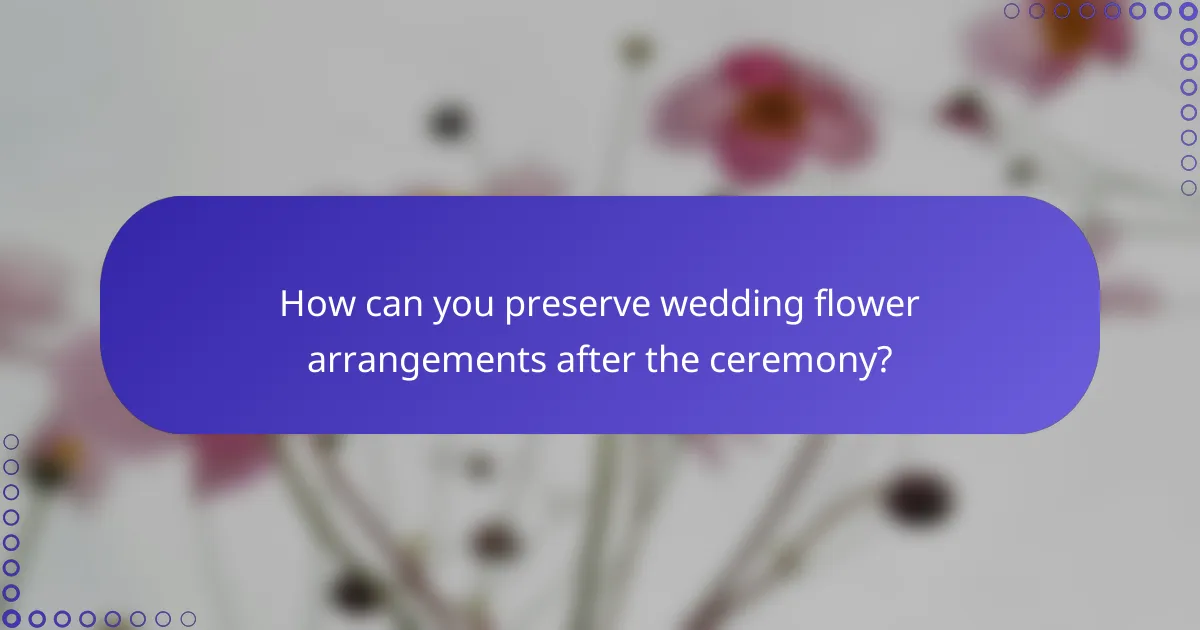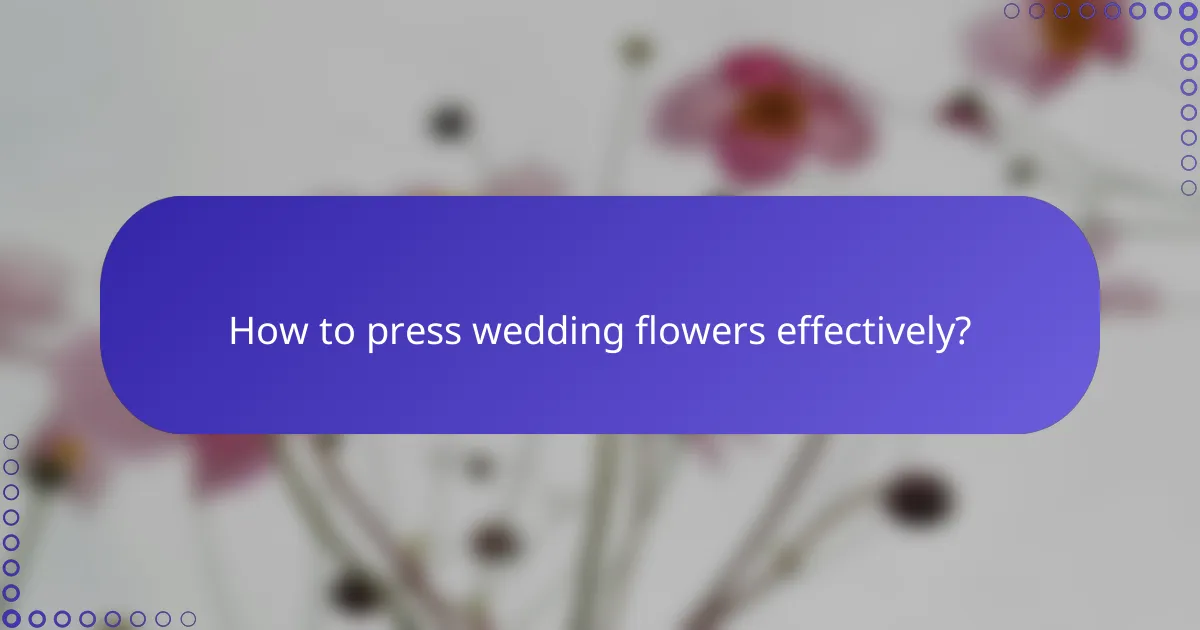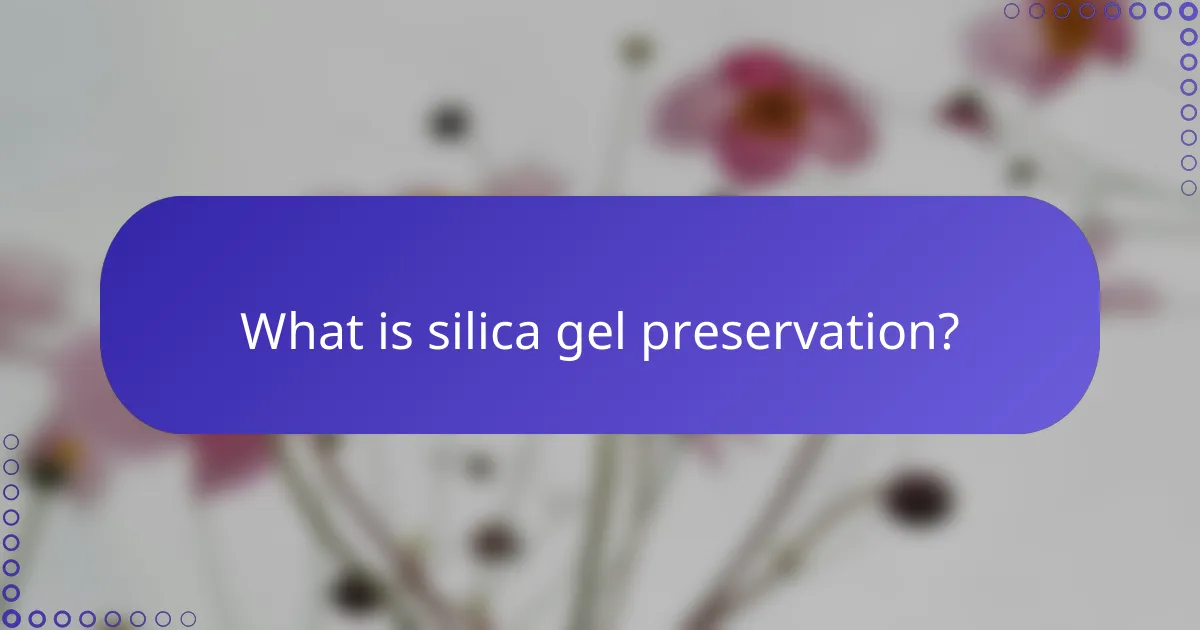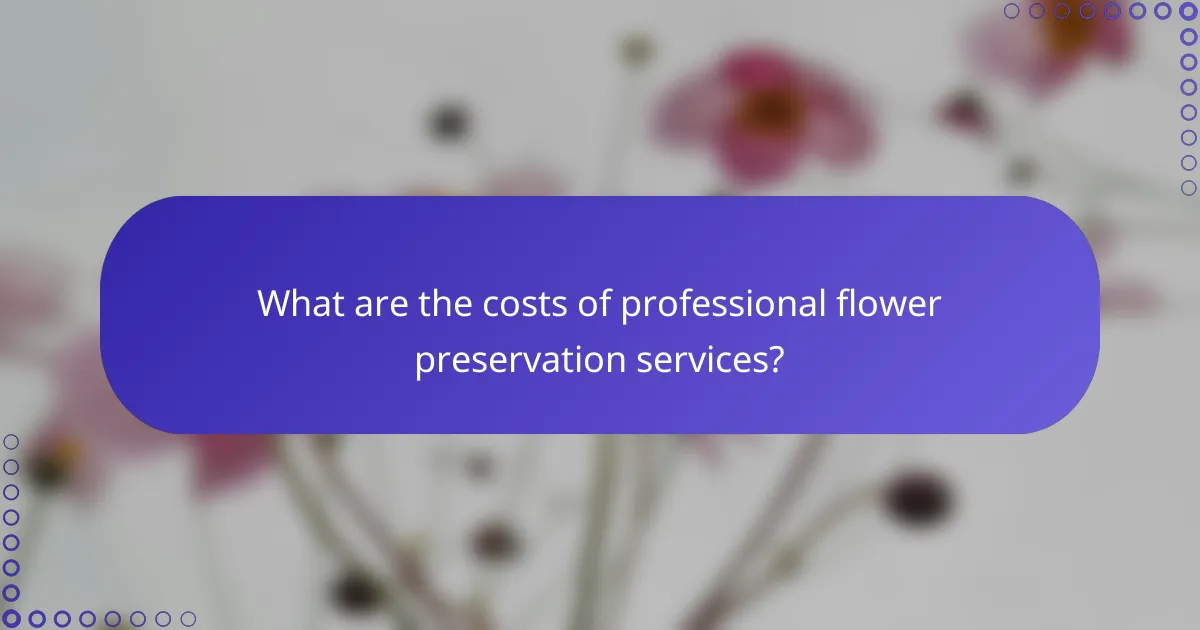Preserving wedding flower arrangements after the ceremony can help maintain their beauty and sentimental value. Various methods exist, each with its own advantages and considerations, allowing couples to choose the best option for their needs.

How can you preserve wedding flower arrangements after the ceremony?
Preserving wedding flower arrangements after the ceremony can help maintain their beauty and sentimental value. Various methods exist, each with its own advantages and considerations, allowing couples to choose the best option for their needs.
Air drying flowers
Air drying is a simple and cost-effective method for preserving flowers. To do this, tie the stems together and hang the bouquet upside down in a dry, dark, and well-ventilated area. This process typically takes a few weeks, and the flowers will retain their shape and color to some extent.
Consider using flowers with sturdy petals, such as roses or lavender, as they tend to dry better. Avoid high-humidity environments, as moisture can lead to mold growth during the drying process.
Pressing flowers
Pressing flowers is another popular preservation technique that results in flat, decorative pieces. To press flowers, place them between sheets of parchment paper and use a heavy book or a flower press to apply pressure. This method usually takes several weeks for complete drying.
Pressed flowers work well for creating keepsakes like framed art or greeting cards. Choose flowers with a relatively flat shape, such as daisies or pansies, for the best results.
Using silica gel
Using silica gel is an effective way to preserve the color and shape of flowers. This method involves submerging the flowers in silica gel crystals, which absorb moisture quickly. Typically, this process takes about a week, depending on the flower type and size.
Silica gel is available at craft stores and can be reused multiple times. Ensure the flowers are fully covered and check them periodically to avoid over-drying.
Refrigeration preservation
Refrigeration preservation is a short-term method that can extend the life of fresh flowers. By placing the bouquet in a refrigerator, you can slow down the wilting process for a few days. Ensure the flowers are in water and wrapped in a damp paper towel to maintain moisture.
This method is ideal for couples who want to delay the preservation process or need to transport flowers for a few days. However, it is not a long-term solution, as the flowers will eventually wilt.
Professional preservation services
Professional preservation services offer specialized techniques to maintain the beauty of wedding flowers. These services often include freeze-drying or resin encapsulation, which can provide stunning results. Prices for these services can vary widely, typically ranging from a few hundred to over a thousand dollars, depending on the complexity and type of flowers.
Choosing a reputable service is crucial, so look for reviews and examples of their work. This option is ideal for couples who want a lasting keepsake without the hassle of DIY methods.

What are the best methods for air drying flowers?
The best methods for air drying flowers include hanging them upside down and using a drying rack. Both techniques help preserve the flowers’ shape and color while removing moisture effectively.
Hanging upside down
Hanging flowers upside down is a classic method for air drying. This technique allows gravity to help maintain the flowers’ shape and prevents them from wilting. Choose a dark, dry, and well-ventilated area to hang the flowers, as light can fade their colors.
To hang flowers, gather a small bunch and tie the stems together with string or rubber bands. Use hooks, nails, or a sturdy line to suspend them upside down. Depending on the flower type and humidity, drying can take anywhere from a week to several weeks.
Using a drying rack
A drying rack offers a flat surface for air drying flowers, making it suitable for delicate blooms that may get crushed when hung. This method provides good airflow around the flowers, promoting even drying. Place the flowers in a single layer on the rack, ensuring they do not touch each other.
For optimal results, use a mesh or wire rack that allows air circulation. Depending on the flower variety and environmental conditions, drying on a rack can take several days to a week. Regularly check the flowers for dryness to avoid mold growth.

How to press wedding flowers effectively?
Pressing wedding flowers effectively involves flattening them between absorbent materials to retain their color and shape. This method is popular for preserving the beauty of floral arrangements long after the ceremony.
Using heavy books
One of the simplest ways to press flowers is by using heavy books. Place the flowers between two sheets of parchment or absorbent paper, then stack the books on top to apply pressure. Ensure the flowers are not too thick, as this can lead to uneven pressing.
Leave the flowers in the books for about two to four weeks, checking periodically for dryness. This method is cost-effective and requires minimal supplies, making it accessible for most couples.
Flower pressing kits
Flower pressing kits are designed specifically for this purpose and often include a variety of materials to enhance the pressing process. These kits typically come with absorbent paper, pressing boards, and sometimes even a weight system to ensure even pressure.
Using a kit can streamline the process, allowing for more consistent results. Follow the instructions provided with the kit, and consider pressing flowers in small batches to monitor the outcome closely.

What is silica gel preservation?
Silica gel preservation is a method used to dry and preserve flowers by absorbing moisture. This technique helps maintain the flowers’ color and shape, making it a popular choice for preserving wedding bouquets and arrangements.
Benefits of silica gel
One of the primary benefits of silica gel preservation is its effectiveness in retaining the natural appearance of flowers. Unlike air drying, which can lead to browning and wilting, silica gel allows for a more vibrant and intact final product.
Additionally, silica gel is relatively easy to use and can be found at craft stores or online. This method is also versatile, suitable for a variety of flower types, including delicate blooms and sturdy stems.
Step-by-step silica gel process
To preserve flowers using silica gel, start by selecting fresh, fully bloomed flowers. Trim the stems to your desired length and remove any excess foliage. Next, fill a container with a layer of silica gel, place the flowers upright or face down, and gently cover them with more gel until fully submerged.
Seal the container and let the flowers sit for several days, typically around three to seven days, depending on the flower type and moisture content. Once dried, carefully remove the flowers from the silica gel and gently brush off any excess granules.

What are the costs of professional flower preservation services?
Professional flower preservation services typically range from moderate to high costs, depending on the method used and the complexity of the arrangements. Most couples can expect to spend anywhere from a few hundred to over a thousand dollars to preserve their wedding flowers.
Average pricing ranges
The average costs for professional flower preservation services generally fall between $200 and $1,500. Basic preservation methods, such as air drying or pressing, tend to be on the lower end of the spectrum, while more advanced techniques like freeze-drying can be significantly more expensive.
For example, pressing flowers might cost around $200 to $400, while freeze-drying could range from $600 to $1,200 depending on the size and number of arrangements. Additional services, such as custom framing, can further increase the total price.
Factors affecting costs
The size and complexity of the floral arrangements also play a role. Larger bouquets or intricate designs require more labor and materials, leading to higher prices. Additionally, the geographical location of the service provider can affect costs, with urban areas often having higher rates than rural ones.

How to choose the right preservation method for your flowers?
Selecting the right preservation method for your wedding flowers depends on factors like the type of flowers, your budget, and how you plan to display them. Common methods include drying, pressing, and using resin, each offering different aesthetics and longevity.
Air Drying
Air drying is a simple and cost-effective way to preserve flowers. Hang your flowers upside down in a dark, dry area with good airflow. This method works best for sturdy blooms like roses and lavender, typically taking a few weeks to fully dry.
To enhance the process, consider using silica gel, which can speed up drying and help maintain color. Ensure the flowers are not overcrowded to prevent mold and uneven drying.
Pressing
Pressing flowers is ideal for creating flat, decorative pieces. Place flowers between sheets of parchment paper and use a heavy book or a flower press to apply pressure. This method usually takes a few weeks and is best suited for delicate flowers like daisies and pansies.
Once pressed, you can frame the flowers or use them in scrapbooks. Keep in mind that pressing may alter the color and texture of the flowers, so choose blooms that retain their beauty when flattened.
Resin Preservation
Resin preservation encases flowers in a clear epoxy, creating a durable and visually striking display. This method requires careful handling and can be more expensive due to materials and labor. It’s suitable for a variety of flowers, but be aware that some may discolor over time.
Ensure you follow the manufacturer’s instructions for mixing and curing the resin. This method can take several days to complete, but the results are often stunning and long-lasting.
Freeze Drying
Freeze drying is a professional method that removes moisture while preserving the flower’s original shape and color. This process can be costly and typically requires sending your flowers to a specialized service. However, the results are often exceptional, making it a popular choice for high-end preservation.
Consider this method if you want to maintain the flowers’ natural beauty for years. It’s particularly effective for delicate flowers and can take several weeks to complete, depending on the service provider.


